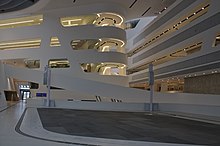 Nanjing International Youth Cultural Centre, a neo-futuristic skyscraper in Nanjing, China[1] | |
| Years active | 1960s–present |
|---|---|
| Location | International |
| Major figures | Peter Cook, Cedric Price, Renzo Piano, Richard Rogers, Norman Foster, Santiago Calatrava, Zaha Hadid |
| Influences | Futurism, high-tech architecture |
| Influenced | Parametricism |

Neo-futurism is a late-20th to early-21st-century movement in the arts, design, and architecture.[2][3]
Described as an avant-garde movement,[4] as well as a futuristic rethinking of the thought behind aesthetics and functionality of design in growing cities, the movement has its origins in the mid-20th-century structural expressionist work of architects such as Alvar Aalto and Buckminster Fuller.[2]
Futurist architecture began in the 20th century starting with styles such as Art Deco and later with the Googie movement as well as high-tech architecture.[5][6]
- ^ Bethune, Meredith (31 July 2019). "An Inside Look at One of Zaha Hadid's Final Projects: China's Futuristic Jumeirah Nanjing Hotel". Robb Report. Retrieved 20 April 2022.
architect Zaha Hadid, the first woman to win the prestigious Pritzker Architecture Prize, died unexpectedly in 2016. Adding to that tragedy were her many projects left unfinished, including the Nanjing International Youth Cultural Centre (IYCC) in China. Fortunately, her London-based firm Zaha Hadid Architects has carried the torch, making it possible for a new hotel, Jumeirah Nanjing, to open inside the building
- ^ a b "Neo-futurism". Designing Buildings,the Construction Wiki. 14 May 2021. Retrieved 20 April 2022.
neo-futurist aesthetics 'generates the emergence of artistic modes that would have been impossible prior to computer technology.'
- ^ "Santiago Calatrava's Neo-Futuristic Architecture". Special Travel International. Vancouver. Retrieved 20 April 2022.
Calatrava's artistic sensibility hasn't been limited strictly to architecture. He is also an accomplished sculptor and painter, creating a body of work on a smaller scale
- ^ "Neo-futurism: An Overview for Students in Architecture Training". digitalschool.ca. 14 June 2018.
- ^ Tyc, Grzegorz (2018). "(Re)searching Forms of the Future. Futurism and Contemporary Architecture" (PDF). Krakow. Retrieved 20 April 2022.
The pavilion in the form of a spaceship designed by Zaha Hadid is a perfect place for a futuristic fashion show. Apart from architecture, Zaha Hadid designed fashion, and the catwalk for Chanel.
- ^ Asim, Farhan; Shree, Venu (July–September 2018). "A Century of Futurist Architecture: from Theory to Reality". Journal of Civil Engineering and Environmental Technology. 5 (6): 338–343. ISSN 2349-8404. Retrieved 20 April 2022.
To create a clear distinction between the futurist architecture of 1910–1920 and the architecture of post 1950s, futurism was renamed as 'Neo-futurism' by French Architect Denis Laming